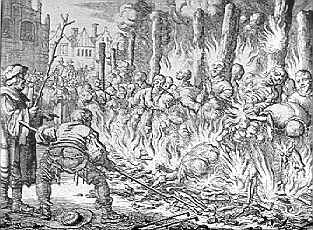Jesus as Example
The early Anabaptists emphasized Jesus as an example for Christian life. They believed that Jesus was the model for how Christians should act and think in their everyday lives. This commitment to follow in his footsteps was reflected in the term discipleship, which remains an important emphasis to this day.
Differences with other Reformers
The early Anabaptists criticized Luther's movement for preaching a kind of "cheap grace." It seemed as though some thought, "If I am saved by grace, then it doesn't matter what I do! After all, God will forgive me." The Anabaptists thought that being a Christian should change your behaviour, too, and questioned whether Luther's ideas actually brought much change from the previous church. They often used a tree as an analogy, with comments like "Of what benefit is a tree if it does not bear fruit?" In other words, what good is it being a believer if people can't tell by your actions?
| "No one can truly
know [Christ] unless [one] follows him in life, and no one may
follow him unless [one] has first known him"
Hans Denck in Kropf, p. 29 |
On the other hand, many in other Reform movements accused the Anabaptists of teaching salvation based on "works." They emphasized God's undeserved grace, with statements like, "No one can earn God's love and forgiveness, we just have to accept it as a gift." If this grace was indeed a gift, it could not be earned in any way.
Consequences of this Disagreement
Although this now seems to be a relatively small difference, it had major implications and repercussions in the 16th century. The early Anabaptists' perspectives on peace, baptism, church and state, and the role of the community all emerged from the desire to follow Jesus faithfully in life. Seen together, these beliefs challenged the regionally-based churches, both Catholic and Protestant. Holding these beliefs resulted in severe persecution.
Acceptance of Suffering
The Anabaptists believed that their "suffering for the faith" was another important way in which they followed the example of Jesus. This was often reflected in prayers, such as the following:
Prayer of Eighteen Martyrs at Salzburg
O God of heaven,
watch over your sheep,
who are such a little flock,
that we may not depart from you
or be led astray.
Keep us under your protection...
and sustain us in your will.
Grant that those who teach false doctrine
may amend their steps and do your will.
Fill us with your divine power, O God,
for we have no other Lord in heaven and earth
but you. Amen. (Snyder, 101)
Martyrs' Mirror
| The Martyrs' Mirror, Modern English Translation |
The Martyrs' Mirror was a collection of stories of Christians who had been persecuted and killed for their faith. The text, over 1000 pages long, was first published in 1660. In the 1685 edition the stories were often accompanied by depictions of gruesome torture and executions, such as that above and other drawings on this site. The picture on the left is the only illustration from the 1660 edition, taken from the title page. Translated, the first section reads:
The Bloody Theatre of the Anabaptists and Defenseless Christians
Who Suffered and Died for the Testimony of Jesus, Their Saviour,
From the Time of Christ to the Year A.D. 1660
Created 1998 by Derek Suderman
